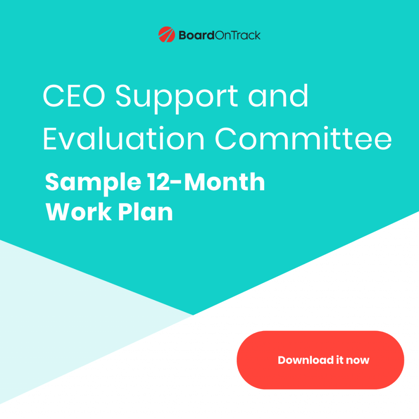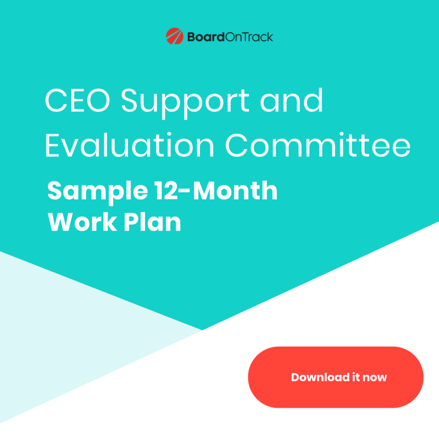
Year-Round Charter School Leader Support & Evaluation
Having worked with over 500 charter school boards, here at BoardOnTrack we know that the most effective charter school organizations have a strong partnership between the Board and their CEO that is built on mutual trust and respect.

Our year-round charter CEO evaluation cycle allows you to get a bead on how your partnership is doing and touch points throughout the year and then the end of year evaluation.
We’re all in this charter world to build great public schools across the country. And having a really effective leader is an important part of making great schools for the kids and families you’re serving. Your board’s responsibilities include making your leader feel valued, giving them great feedback, and showing them ways to improve as a leader.
We have pretty high standards about how to go about governing — and that includes how to support your leader. If you find you’re not able to do all the steps we recommend just yet, take this approach as a vision of what you’re aiming for.
Quick reminder: we use the term CEO to denote the person at the very top of the organization, who reports directly to the board. Some call this the head of school, principal, or executive director.
Effective leaders actually want their board to evaluate them.
Effectively executing an excellent CEO evaluation process can lead to higher engagement, productivity, and retention of your CEO. And ultimately, that all contribute to a stronger organization.
Charter school leaders spend a huge amount of time training, coaching, and supporting their staff. They have really robust feedback loops and end-of-year performance reviews.
Your CEO can feel slighted if the board doesn’t do an evaluation of their performance.
Board members are sometimes surprised to know that CEOs really want to be evaluated. But leaders do, and they want an effective one.
Before you begin, make sure your CEO’s job description and goals are in order.
Your CEO needs a job description that sets clear expectations from the outset. The job description must be approved by the board and reviewed annually. Here’s a sample charter school CEO job description that you’re welcome to use as the basis for your own.
And while the job description sets expectations, the goals are the metric against which a CEO’s performance must be measured.
Set up and follow a proven year-round process
Your process must be clear, consistent, and year-round.
There shouldn’t be a scramble to determine when or how to evaluate the CEO at the last minute. And the actual annual evaluation shouldn’t be the only opportunity for the board to help the CEO raise the bar for themselves or the organization.
And you don’t need to make it up from scratch. We’ve helped hundreds of charter school leaders effectively utilize our proven CEO evaluation process. With access to the BoardOnTrack platform, you can even be guided through the process, step by step, along with given tools to track evaluation results year over year.
Here are some of the key steps to follow, whether you’re setting up an evaluation process for the first time or refining a process you’ve led over time.
Form a CEO support & evaluation committee.
Who should serve on this committee? We recommend the board chair, and preferably someone with HR or managerial experience.
You might be lucky enough to have someone on the board who works in HR as their day job. They help design and implement performance reviews all day long in their professional life. It would be great to have someone with that background on this committee.
Three members tend
Learn more about how to successfully form and run your CEO Support & Evaluation Committee here.
Develop a timeline.
Map backward from your desired end date and write down the process steps in the timeline. Make sure you understand all the steps, who’s going to do what, and when each step will be completed.
Definitely get input from the CEO here. We’ve seen a lot of boards come up with a timeline and then just hand it down to the CEO. And, in most cases, this results in a plan that doesn’t mesh with the CEO’s realities. Maybe it conflicts with spring break or when the state testing is or things that the CEO would know.
So work with the CEO on the timeline and plan your process to allow the CEO to devote the time and energy to make a good process. For instance, the due date for their self-evaluation needs to be doable for them.
Note that your timeline will be approved by the full board. So put it on the agenda for a vote, and submit it as a document so the board has what they need to approve it.
Determine what tool or instrument you’ll use.
How will you actually measure your evaluation, and do so consistently, with the same tool from one year to the next?
The same survey instrument should be completed by the CEO, the full board and the direct reports. You could use a homegrown tool. That’s a lot of work. But we’ve seen people do it. There are other options out there.
Ideally, you’ll choose one that’s been road-tested with charter schools nationwide. Because the charter school CEO job is unique. And the other tools that we’ve seen really focus on a superintendent role, like a district superintendent or the principal job only.
The district public school principal doesn’t have fundraising and financial oversight and other things like that. And the superintendent job just vastly different from that of a charter CEO.
Of course, we strongly recommend our own online tool, which is built into the BoardOnTrack platform. It’s been built on the lessons learned from our work with hundreds of charter school boards across the country. And it’s the only one exclusively designed for charter schools.
Determine what additional data points will be used.
Even once you’ve chosen your evaluation instrument, you probably want to include some other data that’s specific to your organization.
For example the state test scores, annual parent satisfaction surveys, staff satisfaction surveys. Or there might be a report from your CEO on the board-approved goals that you set for the year — and how they’re doing towards completing them.
Think of it as if you’re building a portfolio of data points. In the survey instrument, you’re asking questions; maybe rating on a scale of one to five how the CEO has performed.
Then, the CEO will evaluate themselves using the same tool. And we want the CEO to ask themselves: what evidence is there to show that I have achieved this rating. And then come up with the additional data points to support that rating.
For
One survey instrument isn’t going to capture or document everything that needs to be collected. This portfolio approach helps allow for that.
The CEO completes a self-evaluation.
The CEO should complete a self-evaluation and share it with the board before the trustees begin their evaluation of the CEO.
Understanding how the CEO is feeling about their own performance can be really helpful before each trustee completes the evaluation survey.
When you sit down to do your evaluation of the CEO, you can look at the CEO’s self-evaluation and see if they’re being too hard on themselves — and you want to give them a pat on the back. Or, if they’re giving themselves a pass, rating themselves too high, and the board has to correct their assumptions.
The self-evaluation can also be shared with the CEO’s direct reports. That’s optional. But it’s helpful for the direct reports to understand how the CEO rates themselves before they weigh in with their own responses to your evaluation survey.
The board and the direct reports complete their evaluation of the CEO.
Have the full board complete the evaluation by the agreed upon time. Sometimes, boards choose to have just the chair or just the officers complete the evaluation. But you really want every trustee to weigh in, as well as direct reports.
Discuss the results with the full board.
The key here is to agree to speak with one voice. Even if you don’t all agree.
There can be areas where your split. There may maybe nine of you who feel the CEO’s doing really well on one thing; and one or two people who don’t. The majority rules. Just talk that through.
Create a summary memo to communicate the results to the CEO. The memo highlights the things that the board feels are going well; and what they want to be improved. The committee will draft the memo for the full board’s review to ensure it reflects the board’s unified voice.
Hold an in-person meeting with the CEO to share the memo and discuss the overall evaluation results. During this meeting, you’ll also come up with goals and an action plan for the next year. Ideally, this is a smaller subset of the full board — perhaps only the committee.
Note that some CEOs are adamant that they want to read and digest the feedback prior to the meeting. You’ll need to decide what works best for your team. We strongly recommend sharing the written feedback after the meeting.
Establish an action plan and goals for the next year.
This is a really important step that often gets left out. Once you give the feedback, what are those measurable goals? What’s the improvement plan? Perhaps there are both personal and professional development goals, alongside overarching organizational goals.
In some cases, the CEO drafts their own goals for next year and reviews these with the CEO Support & Evaluation Committee. Either way, the committee will present the CEO goals to the full board for approval.
And the process starts all over again.
The CEO will now spend the next 12 months pursuing their approved goals, reporting out at board and committee meetings on their progress, and receiving regular support and check-ins from the CEO Support and Evaluation Committee.
This Charter school leader support and evaluation is essential for success as an organization. Learn more about best practices in this Board-CEO partnership in a recent webinar with BoardOnTrack.


Mike Mizzoni
With years in higher education, board governance, law, and state and local politics, Mike provides leadership and governance training to BoardOnTrack’s members.
